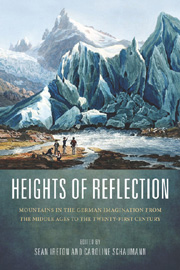 Heights of Reflection
Heights of Reflection Book contents
- Frontmatter
- Contents
- Acknowledgments
- Introduction: The Meaning of Mountains: Geology, History, Culture
- Prelude: Classical Mountain Landscapes and the Language of Ascent
- Part I First Forays: Mountain Exploration and Celebration from the Middle Ages to the Eighteenth Century
- Part II Beckoning Heights: Summits Near and Far in the Nineteenth Century
- Part III Modern Expeditions and Evocations: Climbing from the Twentieth into the Twenty-First Century
- Leaving the Summit Behind: Tracking Biographical and Philosophical Pathways in Richard Strauss's Eine Alpensinfonie
- Elevation and Insight: Thomas Mann's Der Zauberberg
- “The Essence of the Alpine World Is Struggle”: Strategies of Gesundung in Arnold Fanck's Early Mountain Films
- “Mountain of Destiny”: The Filmic Legacy of Nanga Parbat
- Spatial Orientation and Embodied Transcendence in Werner Herzog's Mountain Climbing Films
- W. G. Sebald's Magic Mountains
- Conflicting Ascents: Inscriptions, Cartographies, and Disappearance in Christoph Ransmayr's Der fliegende Berg
- Works Cited
- Notes on the Contributors
- Index
“Mountain of Destiny”: The Filmic Legacy of Nanga Parbat
from Part III - Modern Expeditions and Evocations: Climbing from the Twentieth into the Twenty-First Century
Published online by Cambridge University Press: 05 February 2013
- Frontmatter
- Contents
- Acknowledgments
- Introduction: The Meaning of Mountains: Geology, History, Culture
- Prelude: Classical Mountain Landscapes and the Language of Ascent
- Part I First Forays: Mountain Exploration and Celebration from the Middle Ages to the Eighteenth Century
- Part II Beckoning Heights: Summits Near and Far in the Nineteenth Century
- Part III Modern Expeditions and Evocations: Climbing from the Twentieth into the Twenty-First Century
- Leaving the Summit Behind: Tracking Biographical and Philosophical Pathways in Richard Strauss's Eine Alpensinfonie
- Elevation and Insight: Thomas Mann's Der Zauberberg
- “The Essence of the Alpine World Is Struggle”: Strategies of Gesundung in Arnold Fanck's Early Mountain Films
- “Mountain of Destiny”: The Filmic Legacy of Nanga Parbat
- Spatial Orientation and Embodied Transcendence in Werner Herzog's Mountain Climbing Films
- W. G. Sebald's Magic Mountains
- Conflicting Ascents: Inscriptions, Cartographies, and Disappearance in Christoph Ransmayr's Der fliegende Berg
- Works Cited
- Notes on the Contributors
- Index
Summary
In addition to being physical forms, mountains — as Robert Macfarlane writes in the introduction to his 2003 study Mountains of the Mind — are “the products of human perception; they have been imagined into existence down the centuries.” By the end of the nineteenth century, the focus of this imagination in the minds of European, and especially British, mountaineers had shifted from the Alps to the highest mountain ranges in the world. Macfarlane observes: “The imaginary potency of these greater peaks … was formidable, and they frequently became the objects of obsession within the minds of their individual admirers” (16). And not just individuals: while Mount Everest (8,850 m/29,035 ft.) became the obsession of the British, Nanga Parbat (8,125 m/26,658 ft.) fired the imagination of the German nation. Between the early 1930s and 1950s it would become their “Schicksalsberg” (mountain of destiny), and it would be onto its slopes that German mountaineers would project, both figuratively and literally, not only their sporting aspirations but also some of the most pressing social and political concerns of their times.
What exactly were these concerns? In purely sporting terms, the German efforts on Nanga Parbat during the 1930s were motivated by an attitude of competition fueled by British attempts on Everest and their success in consistently pushing upward the world altitude record. But these German expeditions were also the visible expression of a deeply felt desire among German mountaineers for the reconstitution of their nation as a recognizable European, even world, power following the defeat of the empire in the First World War.
- Type
- Chapter
- Information
- Heights of ReflectionMountains in the German Imagination from the Middle Ages to the Twenty-First Century, pp. 285 - 301Publisher: Boydell & BrewerPrint publication year: 2012
